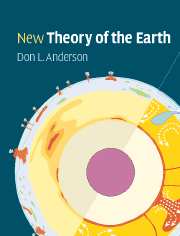Book contents
- Frontmatter
- Contents
- Preface and Philosophy
- Abbreviations and acronyms
- Part I Planetary perspective
- Part II Earth: the dynamic planet
- Part III Radial and lateral structure
- Part IV Sampling the Earth
- Chapter 12 Statistics and other damned lies
- Chapter 13 Making an Earth
- Chapter 14 Magmas: windows into the mantle
- Chapter 15 The hard rock cafe
- Chapter 16 Noble gas isotopes
- Chapter 17 The other isotopes
- Part V Mineral physics
- Part VI Origin and evolution of the layers and blobs
- Part VII Energetics
- References and notes
- Appendix
- Index
Chapter 16 - Noble gas isotopes
Published online by Cambridge University Press: 05 June 2012
- Frontmatter
- Contents
- Preface and Philosophy
- Abbreviations and acronyms
- Part I Planetary perspective
- Part II Earth: the dynamic planet
- Part III Radial and lateral structure
- Part IV Sampling the Earth
- Chapter 12 Statistics and other damned lies
- Chapter 13 Making an Earth
- Chapter 14 Magmas: windows into the mantle
- Chapter 15 The hard rock cafe
- Chapter 16 Noble gas isotopes
- Chapter 17 The other isotopes
- Part V Mineral physics
- Part VI Origin and evolution of the layers and blobs
- Part VII Energetics
- References and notes
- Appendix
- Index
Summary
3He is not here, for 3He is risen!
Anon.Overview
The group of elements known as the rare, inert or noble gases possess unique properties that make them important as geodynamic tracers. The daughter isotopes fractionate readily from their parents, they are inert, and they differ from other geochemical tracers in being gases and diffusing relatively rapidly, at least at low pressure and high temperature. Nevertheless, they can be trapped in crystals for long periods of time. They give information about the degassing history of the mantle and magmas, the formation of the atmosphere, and about mixing relationships between different mantle components. Isotopes made during the Big Bang are called the ‘primordial’ isotopes. Some of the noble gas isotopes are cosmogenic, nucleogenic or radiogenic and these were made at later times. The presence of 3He in a rock or magma has often been taken as evidence for the existence of a primordial reservoir in the mantle, one that had not previously been melted or degassed. A primordial reservoir is different from a primordial component. Primordial and solar components are still raining down on Earth. The most primordial materials on Earth, in terms of noble gases, are on mountain tops, in the stratosphere and in deep-ocean sediments.
Evidence for recent additions of noble gases to the Earth comes from deep-sea sediments where high concentrations of He (written [He]), high 3He/4He ratios (written R) and ‘solar’ neon are found.
- Type
- Chapter
- Information
- New Theory of the Earth , pp. 198 - 210Publisher: Cambridge University PressPrint publication year: 2007
- 1
- Cited by



